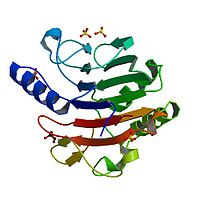Long interspersed nuclear element
 |
|
| Identifiers | |
|---|---|
| ChemSpider |
|
|
Except where otherwise noted, data are given for materials in their standard state (at 25 °C [77 °F], 100 kPa).
|
|
| Infobox references | |
Long interspersed nuclear elements (LINEs) (also known as Long interspersed nucleotide elementsor Long interspersed elements) are a group of non-LTR (long terminal repeat) retrotransposons which are widespread in the genome of many eukaryotes. They make up around 21.1% of the human genome. LINEs make up a family of transposons, where each LINE is about 7000 base pairs long. LINEs are transcribed into mRNA and translated into protein that acts as a reverse transcriptase. The reverse transcriptase makes a DNA copy of the LINE RNA that can be integrated into the genome at a new site. There are about 100,000 LINEs in your genome. Due to the accumulation of random mutations, the sequence of many LINES has degenerated to the extent that they are no longer transcribed or translated. Comparisons of LINE DNA sequences can be used to date transposon insertion in the genome.
The first description of an approximately 6.4 kb long LINE-derived sequence was published by J. Adams et al. in 1980.
Based on structural features and the phylogeny of its key enzyme, the reverse transcriptase (RT), LINEs are grouped into five main groups, called L1, RTE, R2, I and Jockey, which can be subdivided into at least 28 clades.
In plant genomes, so far only LINEs of the L1 and RTE clade have been reported. Whereas L1 elements diversify into several subclades, RTE-type LINEs are highly conserved, often constituting a single family.
In fungi, Tad, L1, CRE, Deceiver and Inkcap-like elements have been identified, with Tad-like elements appearing exclusively in fungal genomes.
The LINE-1/L1-element is the only element that is still active in the human genome today. It is found in all mammals.
Remnants of L2 and L3 elements are found in the human genome. It is estimated, that L2 and L3 elements were active ~200-300 million years ago. Unlike L1 elements, L2 and L3 elements lack flanking target site duplications.
In the first human genome draft the fraction of LINE elements of the human genome was given as 21% and their copy number as 850,000. Of these, L1, L2 and L3 elements made up 516,000, 315,000 and 37,000 copies, respectively. The non-autonomous SINE elements which depend on L1 elements for their proliferation make up 13% of the human genome and have a copy number of around 1.5 million. Recent estimates show the typical human genome contains on average 100 L1 elements with potential for mobilization, however there is a fair amount of variation and some individuals may contain a larger number of active L1 elements, making these individuals more prone to L1-induced mutagenesis.
...
Wikipedia
